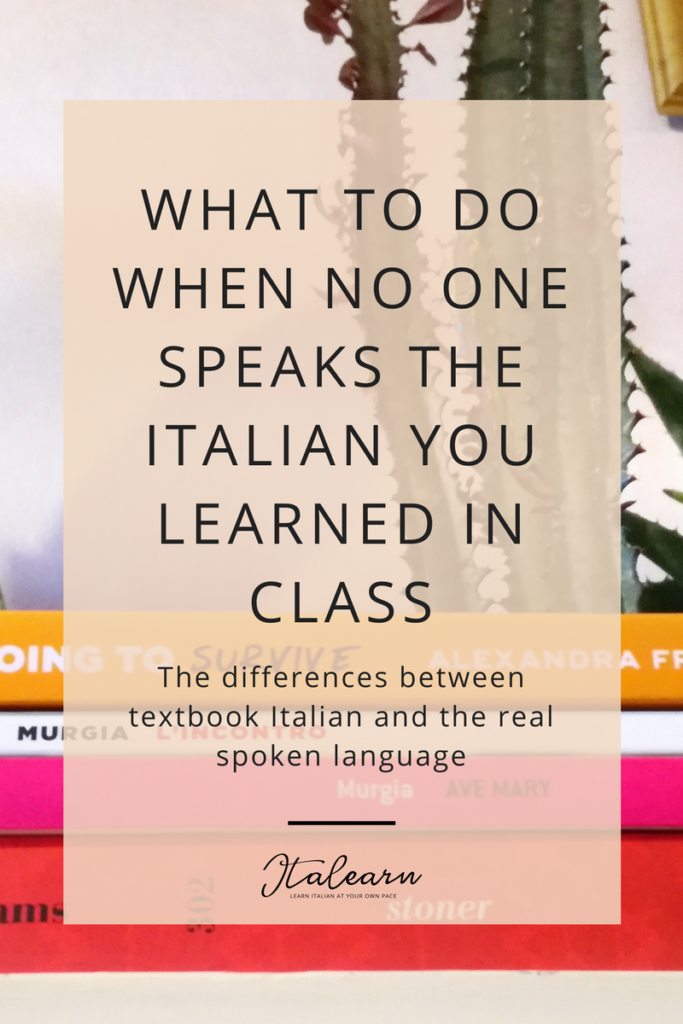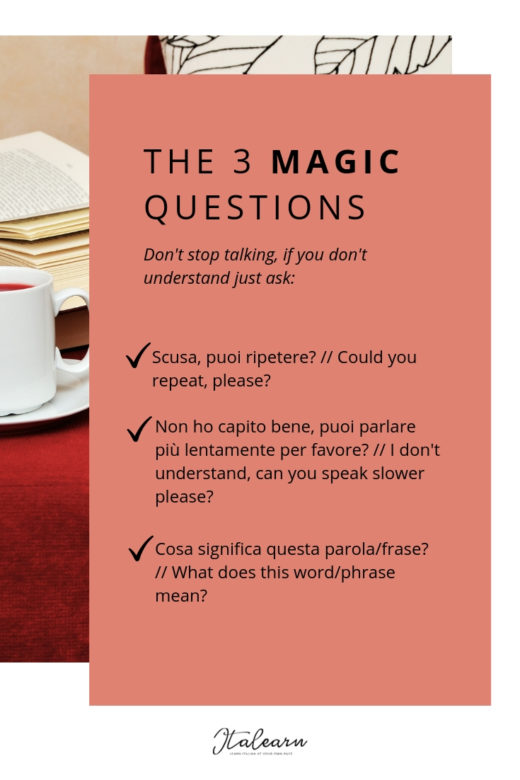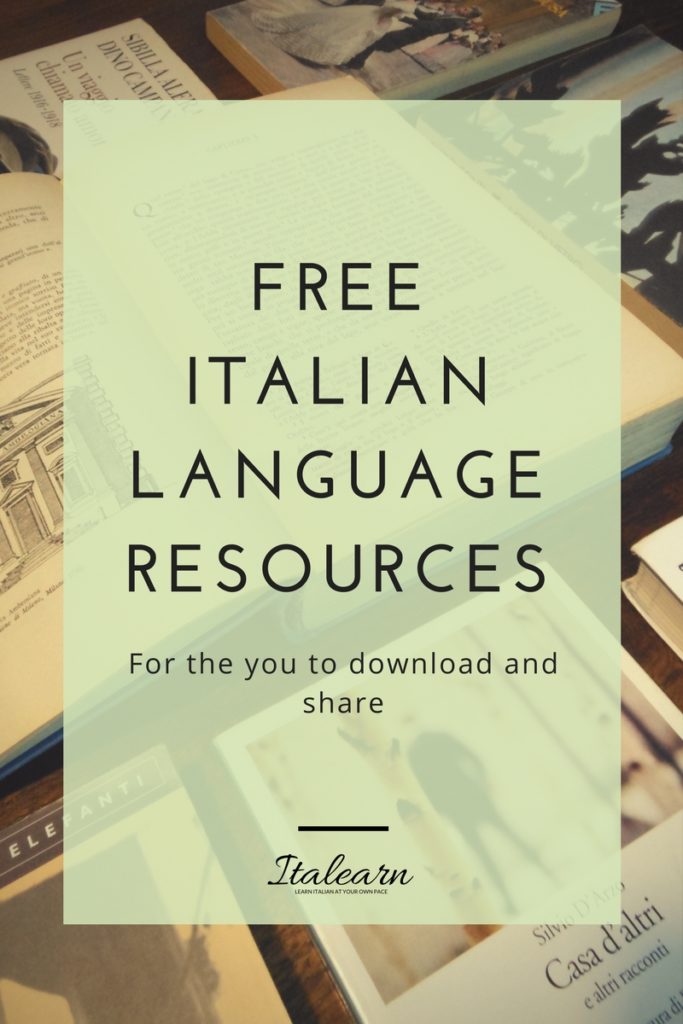Listen to this blog post (18 min)
Omg! I have spent months studying the language and now that I’m in Italy I can’t understand a single word, how is that even possible? I’ll have to nod, pretending I agree with everything when in reality I have no idea what they are talking about!
Don’t bother raising your hand, I know it’s happened to you too. Actually, it reminds me of the first time I have traveled abroad with my class, we went to Germany. It was already my fourth year of studying German, I had both a native and a non-native teacher, so I thought: I’m not going to starve myself, I can survive! Well, although my stomach never complained too much, I can’t really say I have tried Germany’s best specialties.
Let’s give it a specific definition: FOMO. That’s what we feel when we can’t understand another speaker. But why does it happen?
There are many reasons why, and once you are more familiar with them, you will become more aware of the traits that distinguish the spoken language of a native Italian and you will be able to speak the same language.
You can’t run a marathon if you haven’t trained properly, with spoken language, you need to train your ears.
Let’s explore together three elements that will help you understand why often your Italian is different from the natives’ Italian:
- textbook language, this is what you know
- situation & intonation, this is what you don’t pay attention to
- local languages and accents, this is what really happens in Italy.
Textbooks
We have all used a textbook in school, most teachers use them in their private lessons, and I do too. Because they are not that bad, there are very good textbooks around. But, as with most tools, you need to know how to use them in order to make them really work for you.
The language of textbooks is re-created to give a sense of authenticity while practicing the language. It’s not as fluid as in real-life speech, there is no intonation, there are repetitions. We don’t talk like that, no, but it’s the textbook task to train your brain, to make it automatic for you to use certain structures and patterns.
You can think of textbooks as an integration to your learning process. They are a part of it, but not the main part. You have to interact with other sources.
Textbooks can do a lot for you: they help you with rules and examples, they build frameworks that you can use to create sentences, they lay down the main grammar rules.
But when we talk about the Italian language, we talk about a language that is in a continuous state of mutation, it evolves so quickly that sometimes even linguists cannot keep up with it. We also talk about a language that has been influenced by many other languages (and still is), and that has thousands of local variations. So if textbooks can give us a good idea of the spoken language, they cannot be our only tool, we need to find different authentic sources to connect to.
5 authentic Italian language sources that are available on-and-off-line
You don’t need to be in Italy to have direct exposure to the natural spoken Italian language. Here you can find a list of 5 sources to help you train your ear and getting accustomed to how Italians really speak.
Source #1
The teacher you work with is an easily accessible authentic source of the language, maybe not so much when she is teaching, but when she talks more freely she will reveal her accent and possibly some words that are peculiar to her variety of Italian.
Source #2
This source could be a little less authentic (and more challenging, much more challenging!), but it is still valuable: movies, tv series, talk shows, YouTube series. You don’t need to understand, just listen and try to catch the general idea.
Some suggestions:
Tv series (the service is not available in all countries)
- L’amica geniale
- L’ispettore Coliandro
- Rocco Schiavone
- La porta rossa
- Non uccidere
- I bastardi di Pizzofalcone
- L’allieva
- Questo nostro amore
- Raccontami
YouTube
TV Shows
- L’Eredità
- I soliti ignoti
- Guess my age
- Boom!
- Cortesie per gli ospiti
- Quattro ristoranti
- Camionisti in trattoria
Source #3
Social media, they may not be that useless.
I’ve been spending a lot less time on social media recently, but when I’m on, it’s usually because I want to learn something and connect. So my suggestion is to look for groups (on Facebook maybe?) that aim to meet in person, something like what they do in this conversation group in Lucca.
Ever heard of the Meetup platform? I use it too, it’s a great tool for planning and hosting meetings of like-minded people who meet offline. Or maybe you can find live events on Eventbrite.
Your task? Go search Meetup and Facebook for local groups and join them!
Source #4
The online world comes to your rescue again: find a speaking partner through sites like Tandem or Italki Having a speaking partner will probably not solve your grammar-related problems (unless you partner with another grammar geek), but it will be tremendously helpful in boosting your creativity and problem-solving abilities when you can’t find a word!
Source #5
Luckily we don’t always have to do everything online: why don’t you look for native speakers around you?
Maybe that pizzeria on the other side of the street has just hired a new Italian waiter, or your daughter has an Italian roommate in college, or there is a conference in town where Italian speakers will be on stage.
Situation & intonation
Why natural, spontaneous language cannot be found in a textbook? For me, the number one reason is that it lacks the natural, spontaneous elements of situation and intonation.
The context is too basic, it just helps you to frame dialogs, but unless the book uses audio/video examples recorded live, without filters, you will not be able to “feel” the energy of genuine spoken language.
Situation and intonation are interconnected: we use a specific intonation according to the situation. This can be a spontaneous or well-thought decision, but our brain needs to be super fast at identifying the situation+intonation combo or we won’t be able to catch the right meaning and reply accordingly.
Another thing we need to keep in mind is that different languages have different intonation paths, we have to train our ears in the language we’re learning – one technique you can attempt is to listen to an audio clip and talk over it, trying to repeat everything that is being said, at the same speed and rhythm.
But let’s get back to Italian intonation, there’s no better way of understanding how it works than listening to it, so here are a few examples. I’m going to say the same word in different situations, I also add a few extra words to make it sound more realistic.
Basta: it means stop; depending on the context it acquires slightly different shades of meaning.
Listen how a mum who has had enough of her child repeatedly asking for more gelato pronounces this word:
Now listen to how two lovers would ask each other to stop whatever they were saying or doing:
And lastly, listen how you say your prosciutto is enough to the attendant at the deli counter:
Allora: a broad translation of this term can be “so”. As for basta, in the previous example, the meaning changes according to the context.
Listen to a teacher who is speaking in class:
Now listen to someone who is eagerly waiting to know what happened:
In this third example you are going to listen how to express your indifference:
Capito: it means understood, got it. Should I say once again that its meaning can change a little according to the context?
Listen to how it sounds when you say it at the end of a sentence to ask for a confirmation:
Now listen to the intonation of someone who replies to the above question:
And here is our mum again, this time making sure the child has understood that he’s not going to have that extra gelato:
So what’s the moral of the story? When we don’t understand all the words that are being said, then we concentrate on other elements, like situation and intonation for example.
It will take some practice, but when our ears and mind are active, present, and receptive, we have the essential parts of language understanding. From there, it’s all downhill.
Local languages and accents
We have just learned a few things about intonation and how important it is, now we need to add another block of information: in Italian, intonation varies according to where we are in Italy.
A note: I am going to use the terms language, local language, and dialect interchangeably.
It is extremely difficult to explain the varieties of accents and dialects we have in Italy in a single blog post (unless that blog post is 150.000 words, then it’s ok. Maybe).
But I can give you a broad outline of the Italian languages puzzle, yes this can be done.
First things first: in Italy there are both accents and local languages. We all have accents (unless we have been trained to remove them in diction classes), we all use words that belong to our local language, even involuntarily, and we all have born bilinguals.
The difficult task is to trace clear geographical borders, we cannot use the actual regional borders because dialects were present before the country took its present shape. Sometimes inside the same region we can have accents and dialects that differ greatly, or there are dialects that are more similar to those in neighboring regions than those in the same region.
If you are a beginner student and you are in Italy for the first time, it will not be easy to navigate the sea of accents and dialects. If you are a nerd like me, you could spend some time listening carefully to different speakers, but listening to Italian accents is usually not the number one reason people travel to Italy, no?
Accents and dialects don’t have to discourage you though, if you want to try and speak with Italians, just do it, the worst case scenario is that you will laugh together at your mutual incomprehension!
The huge variety of Italian cannot be included in textbooks, we need to use the standard language because it’s the only version of Italian that is understood by all speakers.
As a student of Italian it is perfectly ok to start with the standard language you find in textbooks, understanding accents and dialects is definitely something that you can postpone.
Let’s recap what you can do to become an authentic Italian speaker:
I know it’s easier said than done, so take your time, do your research, and if you need them, use the magic questions:
- Non ho capito bene, puoi parlare più lentamente per favore?
- Scusa, puoi ripetere?
- Cosa significa questa parola/frase?
Don’t be afraid of asking these questions, they may seem embarrassing, but they are exactly the sentences that allow you to have a conversation even if you are a beginner. What’s more, they show you are interested in what is being said, which is always appreciated.
So, what doable steps can you take in order not to freak out when you think you don’t understand natives?
- Use good textbooks and/or
- Work with a teacher if you prefer to
- Add as many authentic resources as possible
- Take a few seconds to recognize the speaking context
- Remember that Italian accents and dialects can be tricky so always ask to repeat.
And my last tip is to be patient. Progress, real progress takes time, don’t waste what you have done up to now just because you don’t give yourself time.


Get better at Italian through creative exercises. Sign up for the free mini-course A story and 5 creative ways to fall in love with Italian and I'll send you the story straight away.
PS: no artistic skills required!
Thank you!
Check your inbox! You have just received an email from me so you can confirm that you really, really want to receive the free guide and updates from me.
Silvia




